Potential Use in Hydraulic Fracturing

Will the new model be a viable alternative to the conventional filter cake model used in hydraulic fracturing? As mentioned, the new model quantitatively described leakoff for Cr(III)-acetate-HPAM gels quite well over a wide range of conditions. The new model was examined to determine whether it would work as well for a guar-borate gel that was commonly used during hydraulic fracturing. The gel contained 0.36% guar, 0.018% NaBO2, 0.24% tallow soap, and 0.1% surfactant. This gel was aged for 1 day at 40°C and injected at 4,130 ft/d through a 6-in.-long, 0.04-in.-wide fracture. The experimental leakoff rates (Figure 1 above) were matched very well using our new model, even though the new model was developed to match the behavior of Cr(III)-acetate-HPAM gels. As with the Cr(III)-acetate-HPAM gel, the pressure gradient during extrusion of the guar-borate gel (through a second 6x1.5x0.04-in. fracture) was insensitive to rate (i.e., pressure gradient rose by a factor of 2.3 as injection flux increased from 206 and 33,000 ft/d).
Of course, the time dependence of leakoff behavior shown above does not prove that the new model is superior to the conventional model for guar-borate gels. Consequently, an extrusion experiment was performed using the guar-borate gel in a fracture where Lf x hf x wf = 12x12x0.04 in. After gel extrusion, the fracture was opened to view the wormhole pattern in Figure 2 below. The presence of these wormhole patterns are consistent with our new model and inconsistent with the conventional filter cake model. Also, during injection of the formed guar-borate gel, the pressure gradients did not rise monotonically as predicted by the conventional model. Thus, the behavior for the guar-borate gel was more consistent with our new model than the conventional model.
